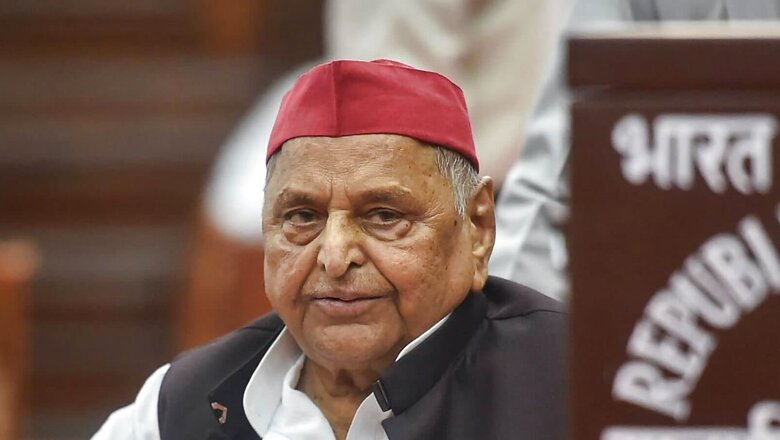
views
It’s a secret that only Mulayam Singh Yadav knew apart from Prime Minister Narendra Modi. It was March 19, 2017, when an aged Mulayam whispered something in the ears of PM Modi which led the prime minister to burst out in laughter. The quintessential ‘Neta ji’ had probably sent out the most powerful message of his clout even in the moment of the biggest defeat for his party. To do so from a stage that had just witnessed the swearing-in of the BJP government in the state, with Yogi Adityanath taking oath as the chief minister, added to the intrigue.
This was, however, not the first of its kind ‘Neta ji’ style in politics. A couple of years later, in February 2019, he yet again threw a surprise when he wished a consecutive second term in office for PM Modi, a gesture which took even the BJP by surprise. The party was then already gearing up for a mega electoral contest against a seemingly mighty alliance of the Samajwadi Party and the Bahujan Samaj Party in the politically crucial state of Uttar Pradesh.
Were these episodes just political courtesy or ‘Shishtachar’ in public life? Or were they also a testimony of Mulayam’s political games? ‘Neta ji’ never ever spoke about the tricks up his sleeve, even as his admirers and critics remained divided in their opinion.
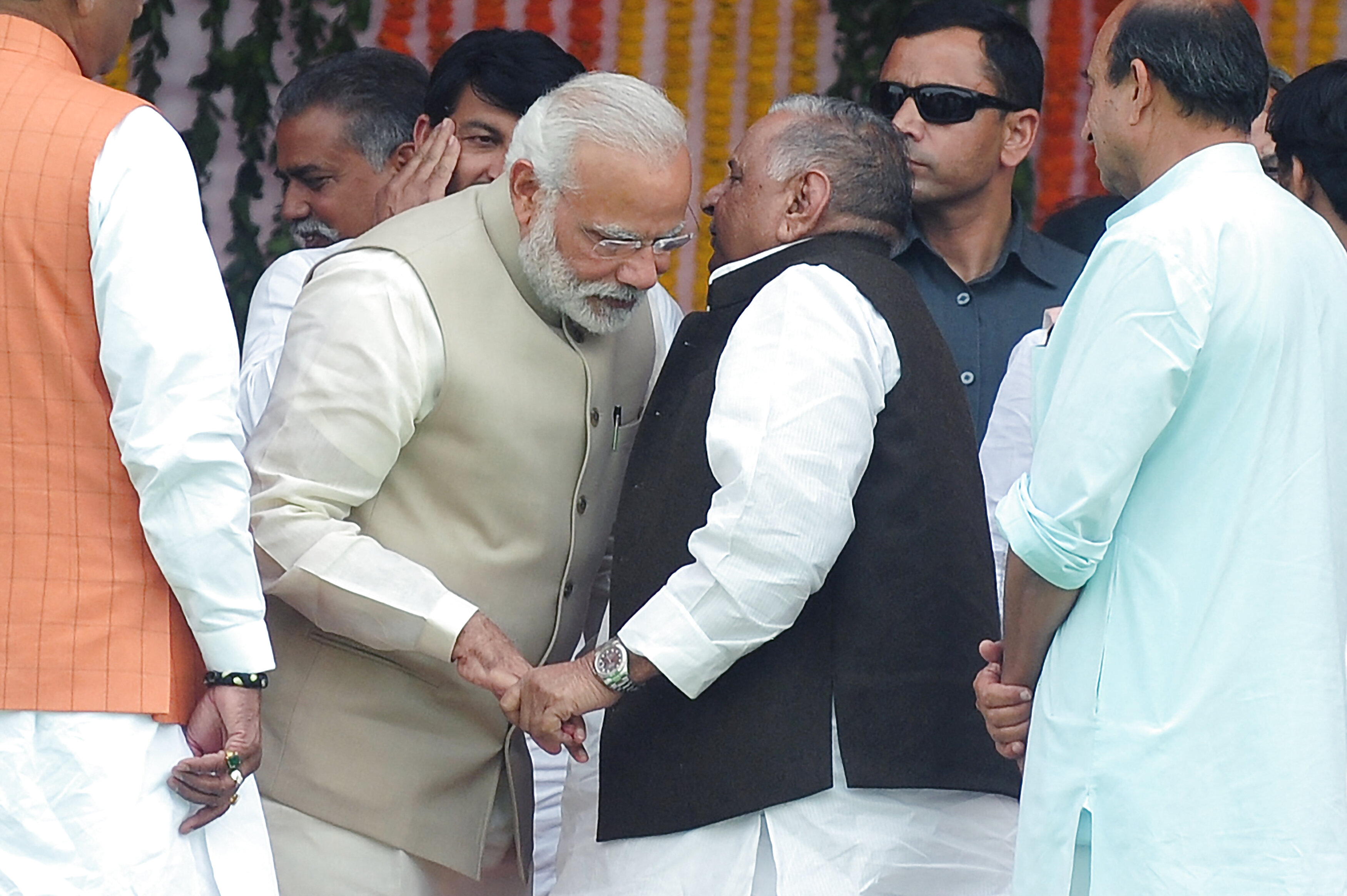
But there is surely no doubt that throughout his social, political journey spanning nearly five decades, the ‘Dharti Putra’ or son of the soil was tempered into steel through unprecedented struggle, a strong resolve to succeed, and an uncanny ability to forge alliances and friendships. His often infamous style of U-turn in politics, commonly referred to as “Charkha Daun", probably stems out of his struggles to survive through the turbulent highs and lows of politics over the decades.
A POLITICAL SCIENCE TEACHER WHO VENTURED INTO POLITICS
Born in a poor, agrarian family in Saifai village of UP’s Etawah district, Mulayam initially wanted to be a professional wrestler. However, his love for studies saw him move ahead in academics and pursue a master’s in political science from BR Ambedkar University, Agra. He then took up a job as a teacher at a government college.
It was after teaching for a few years at the Jain Inter College in Karhal area of Mainpuri that a young Mulayam plunged into electoral politics. For the political science teacher, the years gone by had already given him exposure to the socialist ideas of Dr Ram Manohar Lohiya and Lok Nayak Jai Prakash Narayan. The year 1967 was the beginning of a long political journey for the young socialist Turk who was still a long way away from becoming ‘Neta ji’.
In 1967, Mulayam contested from the Jaswant Nagar assembly constituency on a Samyukta Socialist Party ticket and won. He was just 28 years old. However, the first acid test for the young leader was still a few years ahead in 1975 when a national emergency was declared by the then prime minister Indira Gandhi. Mulayam, by then a second-term MLA, was arrested and stayed behind bars for the next 19 months till the Emergency was lifted.
The prison term hardened the young leader and helped him cement his bond with the leading lights of socialist and non-Congress movements of the age, including the stalwart of farmers’ movement and future prime minister Chaudhary Charan Singh. Charan Singh brought Mulayam to the Bhartiya Lok Dal as the party’s state president. Having won the Jaswant Nagar seat again in the post emergency election of 1977, Mulayam was brought in as the cooperatives minister in the ‘77 Janata party government in the state.
The teacher-turned-politician was now clearly in the higher league of political games but achieving a newer trajectory was still a long and treacherous march ahead — one that Mulayam was strongly destined to wade through over the next one decade.
MANDAL & KAMANDAL — THE DECADE OF TURBULENCE
As the Janata party experiment of uniting the opposition against the Congress collapsed in 1980, Mulayam too lost the assembly election from Jaswant Nagar the very same year. With Mulayam’s fortunes on the wane, it was time for the BJP’s birth. The party came into existence in April 1980 from the remnants of the erstwhile Jan Sangh, setting the stage for a rising tide of Hindutva politics that threatened to replace the socialist opposition against the Congress.
However, the fighter in Mulayam was not ready to surrender. For the next two years, Mulayam — as state president of the Bhartiya Lok Dal — was continuously on the move. From village to village and district to district, he rebuilt the organisation, strengthening his hold and forging a personal rapport with people and karyakartas.
Recalling that period of struggle, Mulayam’s close associate and former MLC Madhukar Jaitley says: “It was that time when ‘Neta-ji’ was barely home. He slept and ate at dhabas for days at a stretch. It was the unwavering commitment and relentless hard work of the early 80s that was to form the strong base of Mulayam’s rise as the chief minister in 1989 and subsequent formation of the Samajwadi party in 1992."
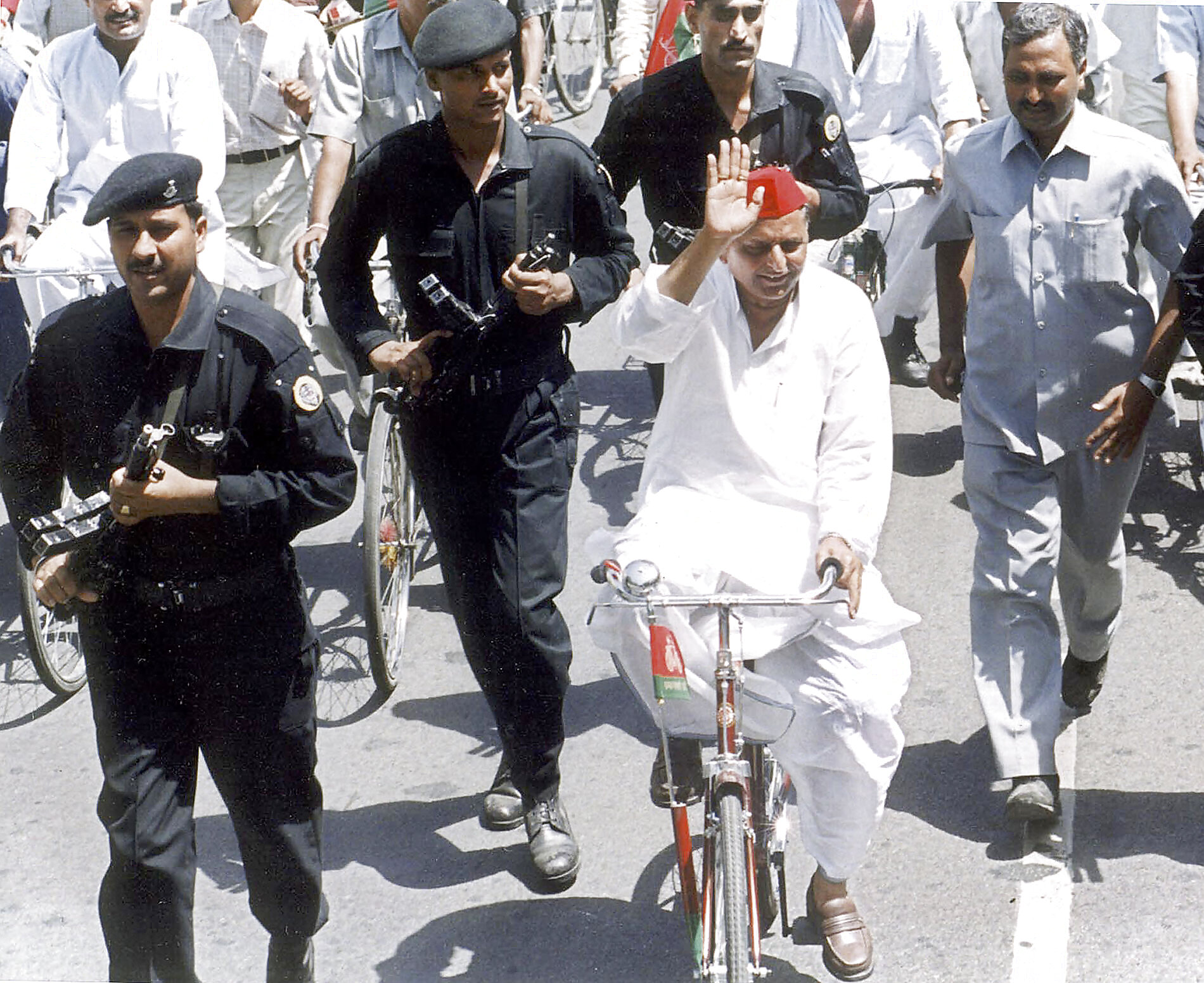
It was also the period when attempts were made on Mulayam’s life by his rivals. In 1982, Chaudhary Charan Singh rewarded him with a seat to UP assembly’s Upper House and he was made the leader of opposition in the legislative council — a post he held till 1985 when the state yet again went for assembly elections.
Over the next few years, as the Congress ruled the state, Mulayam continued to intervene as leader of opposition in the Vidhan Sabha, watching the Grand Old Party trying to battle the rising BJP — sometimes through subtle minority appeasement and sometimes by playing the blatant Hindu card like the decision to open the locks of the Babri Mosque in 1986.
The Congress was further being weakened from within following the open rebellion by its top leader Vishvanath Pratap Singh and the Bofors gun scandal. As VP Singh soon walked out of the party, forming the Janata dal, it was now time for the socialists, including Mulayam Singh, to join ranks with him.
With Congress losing steam, the new political struggle was now increasingly between BJP’s Hindutva politics — Kamandal — and rising consciousness of the backward classes — or Mandal politics — that had cemented behind the socialist forces. Mulayam Singh was soon destined to emerge as the biggest gainer out of the new struggle.
MSY AS CM AND MAKING OF ‘MAULANA MULAYAM’
The assembly elections of 1989 saw Janata Dal storming to power. In the inner struggle for the top job, Mulayam was able to win the support of majority legislators to ruin the ambitions of his rival Ajit Singh, the US-returned engineer son of Late Charan Singh.
The sharp politician in Mulayam by now had also reached out to the Muslim vote bank, which was feeling increasingly threatened by the BJP-RSS’s rising shrill around the Babri Mosque and Ram Janmabhoomi dispute. In October 1990, Mulayam issued a challenge to Hindutva forces planning a ‘Kar Sewa’ at the disputed site in Ayodhya.
Mulayam’s comment — “Parinda bhi par nahi maar payega" — had set the ball rolling for the subsequent firing on ‘Kar Sewaks’ in Ayodhya on October 30, 1990. It was an administrative decision that, in a moment, endeared Mulayam to the minorities as a champion and made him a villain for a section of Hindus.
For the critics, Mulayam was now ‘Maulana Mulayam’. But for the politician himself, it was a moment of building a strong voting block of Yadavs and Muslims or The MY Factor, which was going to be the biggest pillar of strength for him and his future politics.
FORMATION OF SAMAJWADI PARTY & BIRTH OF ‘NETA JI’
Mulayam’s first government lost in 1991, paving way for the BJP to come to power. With Kalyan Singh as chief minister, the state was now heading for the moment when, on December 6, 1992, the Babri Mosque was to be razed down by a mob.
While out of power, Mulayam Singh was busy with the idea of floating his own political party. The brand Mulayam built so far was being tested. There was still no dearth of detractors within. Amidst the frenzied political environment of the period, Mulayam called a three-day convention in Lucknow and on October 4, 1992, the Samajwadi Party was officially declared.
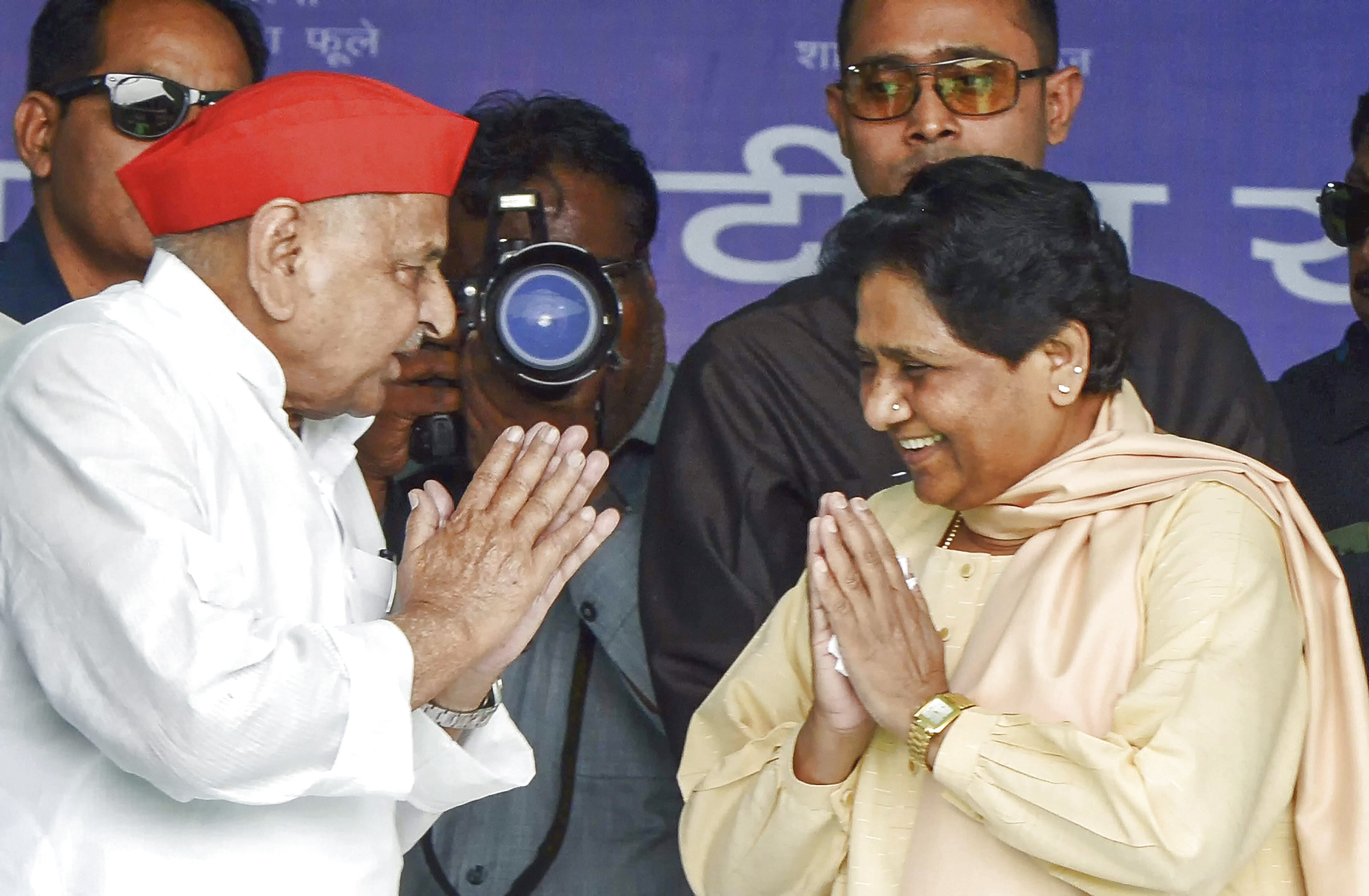
This was the moment when Socialist stalwarts like Janeshwar Mishra endorsed Mulayam as ‘Neta ji’. A respectful address which, from then on, was going to be the synonym of Mulayam Singh across the political spectrum.
TIES WITH BSP GO SOUR
The grand unity of Dalits and Backwards that was much hyped by BSP chief Mayawati and SP president Akhilesh Yadav ahead of the 2019 Lok Sabha polls was probably first envisioned by Mulayam Singh himself. Mulayam had made the first move by supporting Kanshi Ram’s candidature in the 1991 Lok Sabha election from Etawah. The support ensured victory for the BSP founder.
This first successful experiment at Dalit-OBC bonhomie was again put to test in the 1993 Vidhan Sabha elections. The SP and BSP, for the first time, readied a formula to form a joint government with rotation of the CM’s post. However, the friendship was short-lived with the infamous state guest house attack on Mayawati in 1995 — an episode that triggered a rupture so deep within the two sides that it has still not been bridged.
With efforts to forge a natural alliance of the deprived falling apart, it was to be nearly a decade before Mulayam could return to power as chief minister. In between, the only high moment for him was the post of Defence Minister he held from 1996 to 1998 in the coalition government at the Centre.
FINAL INNINGS AS CHIEF MINISTER
The 2002 assembly elections saw Samajwadi Party emerging as the biggest player with 143 seats. However, power still eluded it. It was only in 2003 that Mulayam Singh was able to muster enough allies to reclaim the post of the chief minister, which he held till 2007.
The final period of his chief ministership was also shrouded with some serious allegations of corruption, Gunda Raj, and moral decay with the rise of likes of Amar Singh within the party fold. As criticism mounted, it was almost certain that the party was headed for a humiliating defeat in the coming polls. The 2007 elections sent Mulayam packing, paving way for a full majority government of his arch rival Mayawati.
FATHER ENCRYPTS SON RISE
By 2012, as the state was headed to polls again, 73-year-old Mulayam had probably made up his mind to transfer the baton to his son Akhilesh who had, till then, played a role from the sidelines.
Akhilesh’s youth, his vision and connect with the young voters was the new deal that the father thought could ensure the party’s distancing from its image of promoting lawlessness and ‘Goonda Raj’. During the campaign, as Mulayam increasingly projected Akhilesh, the party was headed for a windfall.
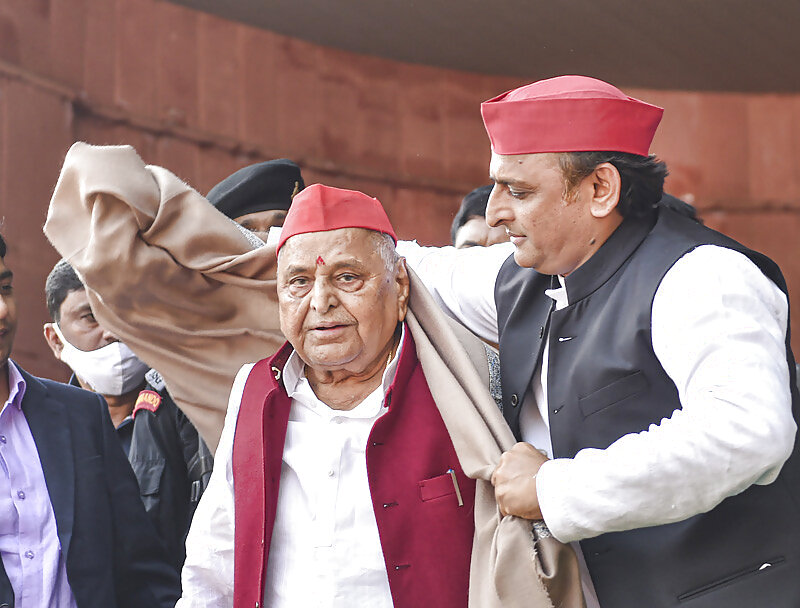
As the Samajwadi Party stormed to victory with a clear majority, there was no doubt over who would be the next chief minister. ‘Neta ji’ had ensured a magnificent shift of power — giving new wings to the party. But cementing his son’s position as the new Numero Uno within the party required some more surgeries.
The years that followed saw a bitter war of succession between Akhilesh and the Old Guard led by his uncle Shivpal. All along the feud, it was Mulayam’s politics that often confused the warring sides. Questions remain to this date if all that happened, including the exit of the likes of Shivpal, was with his silent consent or sheer disregard by his son.
Answers to these questions will perhaps never be clear. In the heydays of that ragging war in his party, Mulayam had told me once: “Running a party of this scale is not an easy task. It is Lord Shiva’s baraat, where you need immense patience and articulation to manage the heads."
Replying to my query about his Mantra to be a successful politician, he had said: “A successful politician should hear more and say less."
This was a trait that Mulayam Singh, who breathed his last on Monday, championed to perfection in his life.
Read all the Latest News India and Breaking News here

















Comments
0 comment